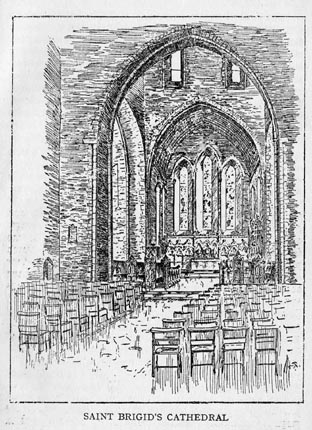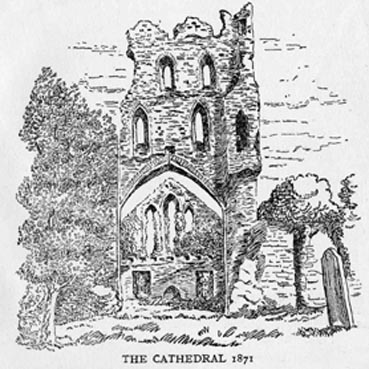« AN TOSTAL SOUVENIR PROGRAMME 1953 - CHAPTER 2 | Main | 2006 CALENDAR OF EVENTS FOR KILDARE TOWN LOCAL HISTORY GROUP »
January 17, 2006
AN TOSTAL SOUVENIR PROGRAMME 1953 - CHAPTER 3
The third chapter of the An Tostal Souvenir Programme from 1953 explored the history of St. Brigid's Cathedral, Kildare.KILDARE CATHEDRAL
The Church erected in the time of St. Brigid and St. Conlaeth was probably of wood, like most of the churches of the period. The earliest description of the Cathedral is that of Cogitosus who, early in the ninth century, wrote as follows concerning “the Church in which rest the glorious bodies of Bishop Conlaeth, and the Virgin St. Brigid on the right and left of the decorated altar, placed in monuments decorated with various embellishments of gold and silver and precious stones with crowns of gold and silver hung above them.
For owing to the increase in the number of the faithful and their being of both sexes, the Church occupied a wide area and was raised to a towering height and was adorned with painted pictures. It has within three spacious oratories separated by plank partitions, under one roof of the greater house, wherein one partition decorated and painted with figures and covered with linen hangings, extended along the breadth of the eastern part of the Church, from one wall of the Church to the other, which partition has at its end two doors. Through the one door on the right the Chief Bishop entered the Sanctuary accompanied by his regular school, and by those who are appointed to the holy ministry of offering Sacred and Divine Sacrifices. Through the other door, on the left part of the aforesaid cross wall, enters the Abbess with her virgins and faithful widows to enjoy the feast of the Body and Blood of Jesus Christ. Moreover another wall separates the floor of the house into two equal parts stretching from the eastward part of the cross wall. The Church has many windows and one ornamental door on the right by which the priests and faithful of the male sex enter the Church, and another door on the left by which the assembly of the virgins and faithful women are wont to enter. Thus in one very great temple, a multitude of people in different order and ranks separated by partitions but of one mind to worship God.”
The Church described by Cogitosus was probably of stone, and half of it was destroyed in 835 when the Danes of Wicklow invaded Kildare. They also carried away the costly shrines of St. Brigid and St. Conlaeth. The relics were saved from desecration, and those of St. Brigid were conveyed for safety to Saul. In 1185 in answer to St. Malachy’s prayer the relics of SS. Patrick, Brigid and Colmcille were discovered. Permission to remove the relics to Down was obtained from Pope Urban III, who sent as his Legate, Cardinal Vivian who, with fifteen bishops, together with abbots, deans, provosts and other clergy were present at the translation. The Shrine of the three great Patrons of Eire was desecrated in 1538.
In 868, Kildare Church was rebuilt by Queen Flanna, wife of Aedh Finliath, King of Ireland. In 1050, Kildare with its Daimliag (great stone church) was burned. They were burned again in 1067. In 1132, St. Laurence O’Toole son of Maurice O’Toole who lived in or near Castledermot, was baptised at Kildare. The Church was plundered in 1136. In 1138 and again in 1150, Kildare was burned. In 1223, when Ralph de Bristol became bishop of Kildare, he found his cathedral in ruins. He rebuilt and beautified it at great expense. Dr. Edmund Lane, Bishop from 1482 to 1513, continued the work of restoring and beautifiying the Cathedral, and built a college for the Dean and Chapter. In 1600, Kildare town suffered so severely that all the houses were in ruins, without a single inhabitant. The Cathedral shared in the general wreck. In 1641, the Cathedral again suffered severely, and its steeple was beaten down by cannonade. In 1643, the town was made a garrison post under the Earl of Castlehaven. Bishop Rosse McGeoghegan restored the ancient Cathedral and and [sic] in March 1643 reconscrated [reconsecrated - sic] it for Catholic use. The wars of the 17th century again left the Cathedral in ruins. In 1686, the choir portion was fitted up for Protestant service, the rest of the building remaining in ruins until 1871, when the restoration of the Cathedral was begun under the supervision of Street, the eminent architect. The work was completed in 1896.
The third chapter of the An Tostal Souvenir Programme from 1953 explored the history of St. Brigid's Cathedral, Kildare.
Spelling and grammar retained - mispellings, mistakes in grammar, punctuation etc. identified by square brackets and sic - [sic]
Posted by mariocorrigan at January 17, 2006 12:08 AM

